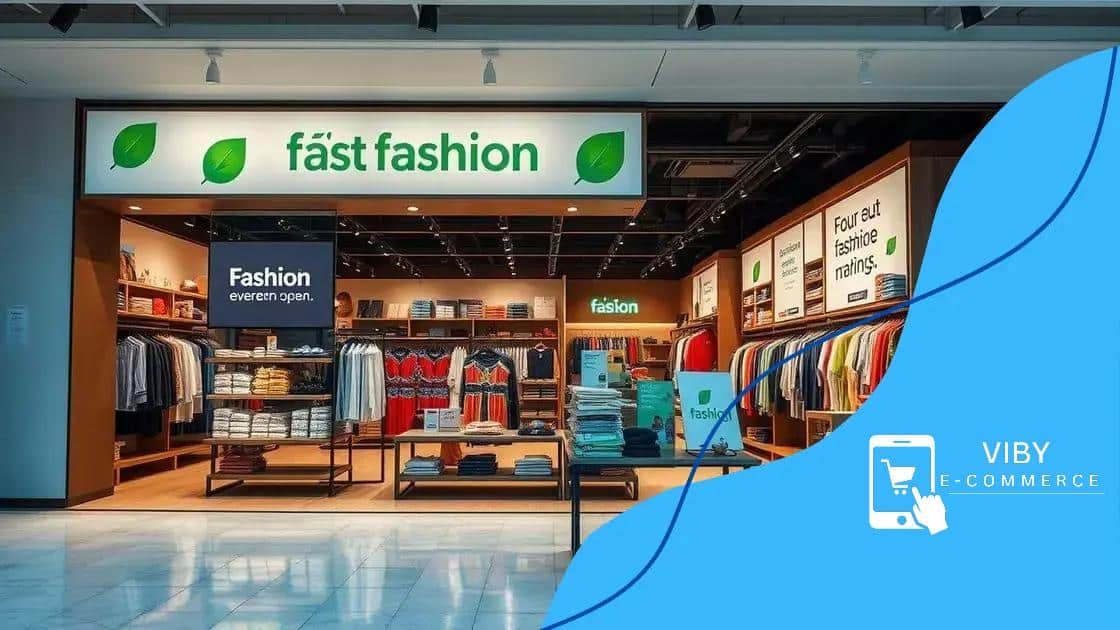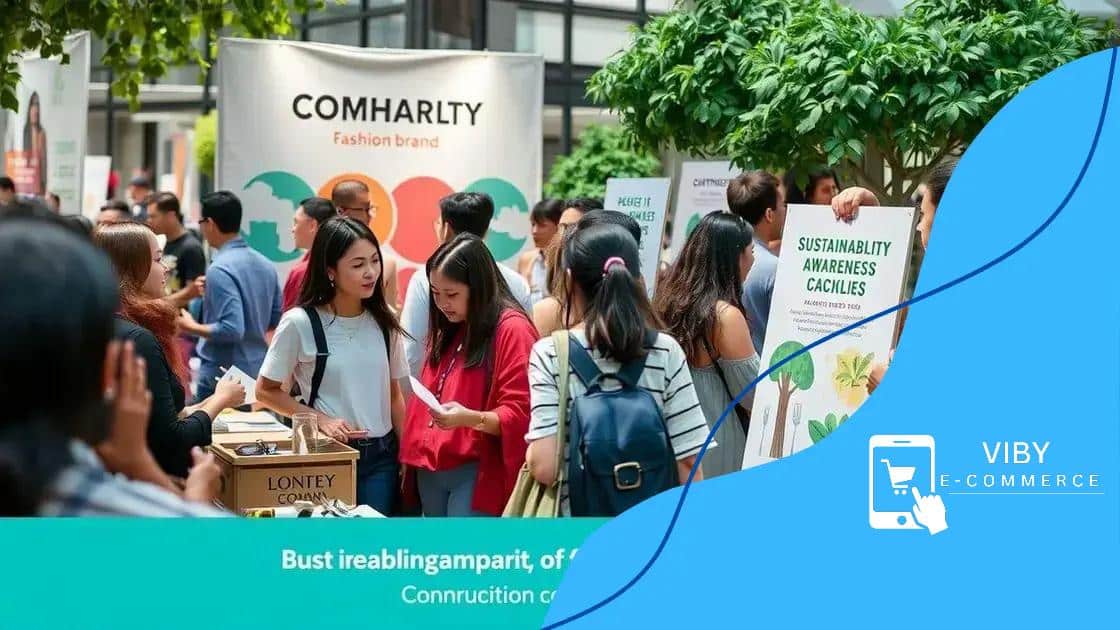How Shein raises awareness about fast fashion’s impact on the environment

Shein raises awareness about fast fashion’s impact on the environment by promoting sustainable practices, using innovative materials, and engaging consumers through educational campaigns and influencer partnerships.
How Shein raises awareness about fast fashion’s impact on the environment can significantly influence consumers’ buying habits. With growing concerns over sustainability, it’s fascinating to see how brands tackle these issues creatively.
The environmental effects of fast fashion
The environmental effects of fast fashion are becoming increasingly alarming. As trends change quickly, countless garments are produced and discarded, leading to significant waste.
Resource Consumption
Fast fashion brands consume large quantities of resources. Water, textiles, and energy are all involved in making cheap clothing.
- Over 2,700 liters of water are needed to make one t-shirt.
- The production process releases harmful chemicals into the environment.
- These brands often prioritize profit over sustainability.
This unsustainable model contributes to climate change. As we continue to demand new styles, the carbon footprint left by manufacturing processes increases.
Waste Generation
Another significant issue is the amount of waste generated by fast fashion. Many items are discarded after just a few uses, leading to overflowing landfills.
According to studies, over 92 million tons of textile waste are created each year. Once in landfills, these clothes can take decades to decompose, releasing harmful toxins into the soil and water.
Moreover, many fast fashion items are not made to last. They are often crafted with cheap materials, which may look good at first but wear out quickly.
Impact on Biodiversity
The impact of fashion on biodiversity is also a critical concern. The use of toxic dyes and chemicals can harm local ecosystems, affecting wildlife and plant life.
Fast fashion often results in deforestation, as trees are cut down to make way for factories. As biodiversity diminishes, ecosystems become unbalanced.
By making informed choices as consumers, we can help combat these environmental impacts. Supporting sustainable brands and reducing our consumption are essential steps.
How Shein promotes sustainable practices
How Shein promotes sustainable practices is crucial for the fast fashion industry. As consumers demand more conscientious choices, Shein is taking steps to showcase its commitment to sustainability.
Sustainability Initiatives
One way Shein promotes sustainability is through various initiatives. These include:
- Implementing recycling programs for old clothing.
- Using eco-friendly materials in their products.
- Reducing water usage in manufacturing.
- Partnering with organizations focused on environmental awareness.
By taking these actions, Shein aims to reduce its environmental impact while attracting eco-conscious consumers.
Transparent Supply Chain
Another important aspect of Shein’s approach is maintaining a transparent supply chain. The brand is becoming more open about where and how its products are made. This includes:
- Detailing factory locations and practices.
- Sharing information about the materials used.
- Highlighting efforts to ensure fair labor practices.
Transparency helps build trust with consumers who are increasingly concerned about ethical production.
Moreover, Shein is investing in technology to enhance its sustainability efforts. This includes utilizing data analytics to minimize waste in production. By analyzing trends and consumer behavior, the brand can make more informed decisions about inventory.
Community Engagement
Engaging the community is another strategy Shein employs. By educating customers about sustainability, the brand fosters a sense of responsibility among its audience.
Shein’s campaigns often include tips on sustainable fashion practices, encouraging shoppers to rethink their purchasing habits. This educational approach not only promotes sustainability but also positions Shein as a leader in the industry.
Engaging consumers through awareness campaigns

Engaging consumers through awareness campaigns is essential for any brand, especially in the context of fast fashion. Companies like Shein have recognized the importance of connecting with their customers on issues that matter.
Types of Awareness Campaigns
Shein utilizes different types of campaigns to inform its audience about sustainability and environmental impacts. These campaigns often include:
- Social media challenges that promote sustainable habits.
- Collaborations with eco-conscious influencers.
- Educational content that highlights fashion’s environmental impact.
By diversifying their approach, they reach a broader audience, encouraging more people to participate.
Interactive Engagement
Another effective strategy involves interactive engagement. Shein has invested in creating platforms where customers can voice their thoughts on sustainability.
For example, the brand often hosts online events or webinars focusing on responsible fashion choices. This direct interaction makes consumers feel valued and more connected to the brand’s mission.
In addition to online events, Shein also encourages feedback from consumers through surveys and polls. This two-way communication fosters community involvement and raises awareness further.
Storytelling and Impact
Using storytelling in their campaigns is a powerful tool. Shein shares stories of individuals making a difference in the realm of sustainability. By featuring real-life examples of how people can reduce fashion waste, the brand not only educates but also inspires.
Such narratives can be very compelling. They connect with consumers emotionally and motivate them to consider their purchasing choices.
Overall, engaging consumers through awareness campaigns is about creating a dialogue. By highlighting meaningful actions and encouraging participation, Shein promotes a sustainable approach within the fast fashion industry.
The role of influencers in fast fashion discussions
The role of influencers in fast fashion discussions is significant. They have the power to shape public perception and consumer behavior. As social media platforms grow, influencers have become key players in promoting brands and raising awareness about sustainability.
Authenticity and Impact
Many consumers trust influencers more than traditional advertising. This trust allows influencers to effectively communicate messages about sustainable fashion. By sharing their personal experiences, they can inspire followers to consider the impact of their choices.
- Influencers often showcase sustainable brands, highlighting their eco-friendly practices.
- They engage their audience in discussions about fast fashion’s environmental effects.
- Collaborating with brands, they promote responsible consumption.
As influencers advocate for change, they also hold brands accountable for their practices.
Trending Topics and Challenges
Influencers frequently create content around trending topics in fashion. They can address critical issues such as waste and manufacturing processes. This content often goes viral, reaching a wider audience.
However, not all influencers embrace ethical choices. Some focus solely on their reach instead of transparency. This can confuse consumers about what constitutes responsible fashion practices.
Brands must ensure their partnerships align with genuine values. Consumers are quick to call out inauthentic practices, which can harm both influencers and the brands involved.
Influencers as Educators
Beyond promotion, influencers also take on educational roles. They provide insights into sustainable fashion trends, encouraging their followers to make more informed decisions.
Many influencers share educational content via blogs, social media, or YouTube. This content often includes:
- Tips for sustainable clothing care.
- Information on the environmental impacts of fast fashion.
- Guides for supporting ethical brands.
By acting as educators, influencers can help shift the conversation around fast fashion towards more sustainable practices. This influence goes beyond just marketing; it fosters a community committed to making a positive impact.
Future trends in sustainable fashion
Future trends in sustainable fashion are evolving rapidly. As the impacts of fast fashion become more evident, both consumers and brands are seeking greener alternatives.
Innovative Materials
One exciting trend is the development of innovative materials. Designers are starting to use fabrics that are not only eco-friendly but also durable.
- Biodegradable textiles made from natural fibers.
- Recycled materials that reduce waste.
- Vegan leather alternatives from mushrooms or pineapples.
These advancements aim to create garments that are both stylish and sustainable. By choosing these materials, consumers can support a healthier environment.
Technology Integration
Another trend is the integration of technology in fashion. Brands are leveraging technology to enhance sustainability in various ways.
- Blockchain for transparent supply chains.
- 3D printing to minimize waste in production.
- Smart clothing that tracks environmental impact.
These innovations not only attract tech-savvy consumers but also create a more ethical fashion system.
Second-Hand and Rental Markets
The second-hand and rental markets are also gaining popularity. Many consumers are becoming more mindful of their impact and are opting for sustainable options.
Brands are responding by offering:
- Online platforms for buying and selling pre-owned clothing.
- Rental services for high-end items.
- Swap events that promote sharing and reuse.
This shift encourages a circular fashion economy, reducing waste and promoting the idea of sharing instead of owning.
Ethical Production Practices
Future trends will likely focus on ethical production practices as well. Consumers are more informed, demanding that brands prioritize fair labor conditions.
Brands are expected to:
- Provide transparency about their labor practices.
- Adopt sustainable sourcing policies.
- Engage in community-building initiatives.
As brands strive to fulfill these expectations, they create a more responsible and equitable fashion industry.
In conclusion, the future of sustainable fashion looks promising as brands, consumers, and influencers work together to create a positive impact. Innovations in materials, technology, and ethical practices are driving the shift towards a more responsible fashion industry. As awareness grows, more people are opting for second-hand and rental options, which helps reduce waste. By supporting these changes, we can all contribute to a healthier planet and a more sustainable future in fashion.
FAQ – Frequently Asked Questions about Sustainable Fashion
What are innovative materials in sustainable fashion?
Innovative materials refer to eco-friendly fabrics made from sources like recycled materials, biodegradable textiles, and even vegan leather alternatives.
How does technology integrate into sustainable fashion?
Technology is used in sustainable fashion to enhance efficiency, such as through blockchain for transparency and 3D printing to reduce waste.
Why is the second-hand and rental market growing?
Consumers are becoming more environmentally conscious, leading to a rise in interest in second-hand and rental options as sustainable alternatives to fast fashion.
What role do influencers play in sustainable fashion?
Influencers help raise awareness about sustainable fashion by promoting eco-friendly brands and sharing insightful content that encourages responsible consumer behavior.





